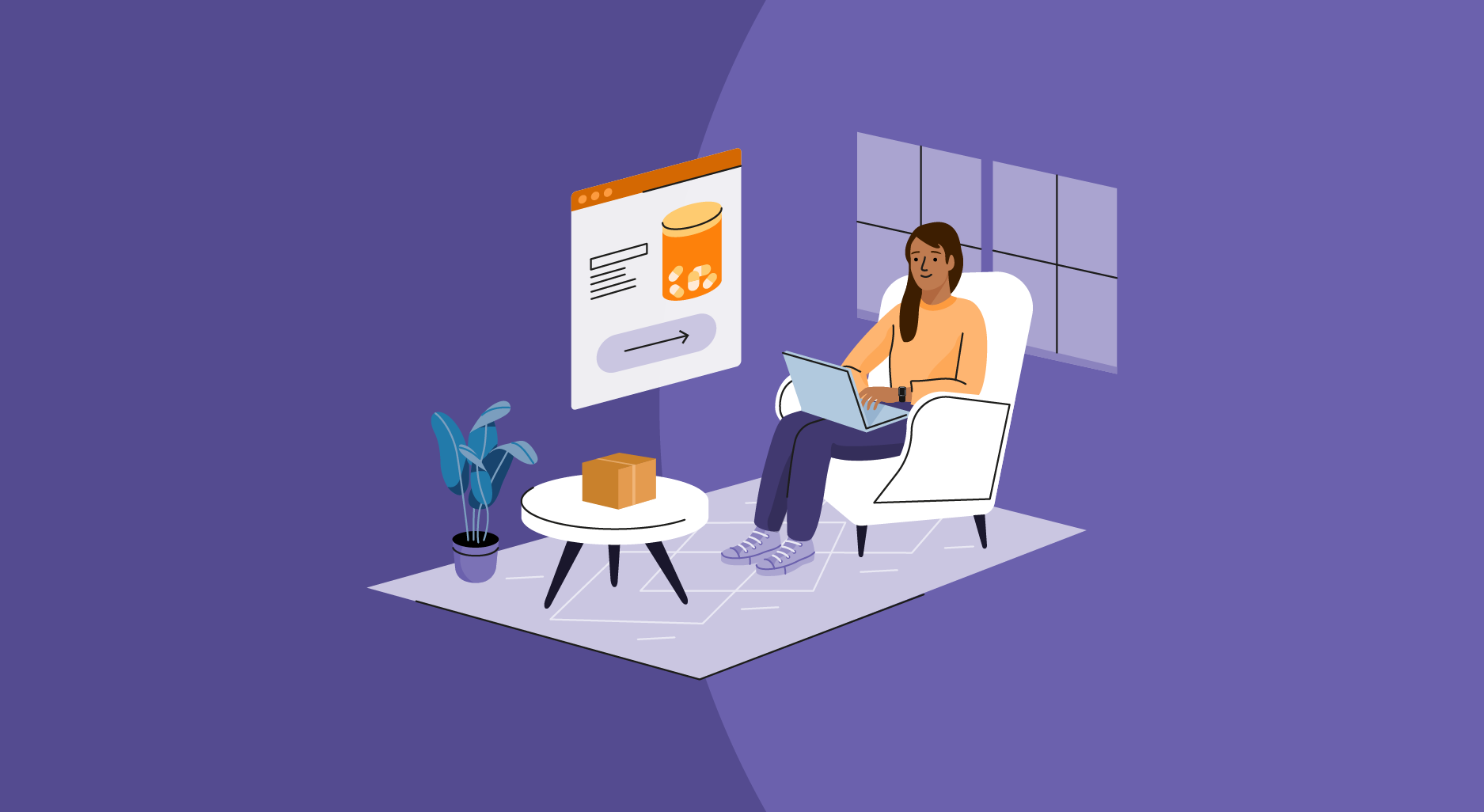[*]
In a time of abundant market disruptions, the healthcare industry is experiencing yet another dramatic change when it comes to how patients are obtaining their medications. Online pharmacies like Amazon Pharmacy and Capsule now compete with traditional retail pharmacies (CVS, Walgreens, etc.).
What is an online pharmacy?
Online or internet pharmacies are often grouped with other non-traditional models such as mail-order pharmacies. These businesses operate by sending prescriptions to patients via mail or same-day delivery, giving them an advantage over traditional pharmacies that require patients to visit in-person to drop off prescriptions and collect medications.
To learn exactly how online pharmacies serve patients, and what healthcare providers should be doing to make sure they’re interoperable with these pharmacies, we surveyed over 1,400 adults in the U.S. who consulted with a healthcare provider and filled a prescription within the past 12 months, and who have had experience using an online pharmacy.[*]
Here’s what we learned:
- 96% of all adults surveyed say technology has made it easier for them to fill prescriptions and manage their medications.
- Among adults who take long-term medications, 60% save at least $20 when filling through an online pharmacy instead of a traditional pharmacy.
- Among adults who have used medication delivery services, 94% say it’s faster than obtaining medications through traditional pharmacies.
We’ll cover:
How do online pharmacies compare to traditional retail pharmacies?
The short answer: they’re better.
The long answer is that they have a number of advantages over traditional pharmacies. We asked patients who use traditional pharmacies how far away they live from their preferred location, and found that the majority are within five miles.

Despite the majority of respondents living fairly close to brick-and-mortar pharmacies, the disadvantages to using these stores to obtain prescriptions are obvious. Most respondents chose “having to leave the house” as their top drawback, which is an issue not easily addressed by the traditional pharmacy model.
About a third of respondents also say that medication costs are higher when filled through traditional pharmacies, and another 23% say wait times are a pain point.

When we directly compared the top drawbacks of traditional pharmacies to the top benefits of online pharmacies (according to customers), we noticed something interesting: They line up perfectly.
The biggest frustrations with in-person pharmacies are also the biggest advantages of online pharmacies: convenience, cost, and time savings.

Let’s dig a little deeper into these three areas to see exactly how online pharmacies compete with traditional retailers.
1. Convenience
There are a number of ways to define and demonstrate convenience, but one way that revealed itself in our survey was through the use of technology.
We asked respondents what their main method of obtaining their prescription drug is and found that over a quarter use apps on their phones to access their preferred internet pharmacy.

We dug a little deeper here to try and understand why so many respondents like using pharmacy apps, and found that 97% of respondents who have experience with these apps say they’re easy to use.

Finally, we asked a very general question about technology’s effect on medication management and, again, an overwhelming majority of respondents said it was positive.

With numbers like these, it’s clear that patients appreciate the ways online pharmacies can improve the overall experience of filling and collecting medications, but they’re also well aware of the more specific advantages.
2. Cost
To get an accurate picture of the cost comparison between online and traditional pharmacies, we narrowed respondents down to 1,187 who are currently on a long-term, regularly-filled prescription medication.
Most of these patients are spending between $50 and $100 to obtain their medicine every single time.

We then asked how much they save, on average, when filling prescriptions with an online pharmacy. The savings are significant.

While 10% pay the same cost regardless of where they fill their prescriptions, 61% save over $20 on average through online pharmacies. Depending on how often these patients fill prescriptions, that could translate into thousands of dollars saved over the course of a year simply by electing to use online pharmacies.
That’s understandably tempting even if it was the only benefit patients enjoyed with online pharmacies, but we know for a fact there are others that make access to online pharmacies a critical service for prescribers to provide their patients.
3. Time savings
Ranking third on consumers’ list of advantages is the amount of time they save when using online pharmacies vs. waiting in line at brick-and-mortar shops for prescriptions to be filled.
One of the clearest ways online pharmacies offer time savings is through medication delivery services, which 98% of respondents have used and 88% find convenient.

We also learned that 94% of consumers save time using online pharmacies, with nearly half (42%) saving at least 10 minutes (on average).

With time and money savings like these, seeing the convenience of online pharmacies over traditional retailers is a no-brainer.
What does this mean for prescribers?
But here’s our next big question: What’s the bottom line for healthcare providers and medication prescribers here?
The answer: They must prioritize connecting with online pharmacies in order to give patients the easiest options for filling prescriptions. Doing so will facilitate better medication compliance and make life easier in general for their patients.
We know from our survey that most patients like to have their doctors send prescriptions directly to their preferred pharmacies.

Which is good news because a piece of legislation called the Ryan Haight Online Pharmacy Consumer Protection Act of 2008 recently went into effect.[1] This act was designed to help the Drug Enforcement Administration (DEA) ensure internet pharmacies are following the right protocols when filling prescriptions for any controlled substance.
The good news is patients are still able to access these medicines if their providers can send prescriptions directly to the online pharmacy they use.
Patients also appreciate not having to handle this part of the process themselves, so doctors should prioritize the ability to interface directly with a variety of pharmacies through e-prescribing.
The next question for healthcare providers looking to connect with online pharmacies is: “Which ones?” The most used online pharmacies are the big names that you would expect: Amazon Pharmacy and Capsule.

While there are some newer options that have hit the market more recently and expect to grow in popularity (such as Mark Cuban’s venture[2]), any provider would be covering their bases by offering the top three or four selections here to start out with.
The good news is that a lot of EHRs are already equipped with the ability to e-prescribe and are interoperable with many popular pharmacies, so providers who aren’t already using those features can start right away without having to make any software changes.
Those who don’t have access to online pharmacies, on the other hand, are shorting their patients on convenience as well as cost and time savings—enough to send any patient looking for a more modern, technologically connected provider who can meet these needs.
Survey methodology
* To collect the data presented in this report, Software Advice conducted the 2022 Online Pharmacy Survey of adults in the U.S. in June 2022.
We used screening questions to narrow the respondents down to 1,482 with relevant knowledge and experience, specifically individuals who had visited a healthcare provider and received a prescription for medication within the last 12 months and who had used an online pharmacy at least once to fill a prescription.
Sources
- Ryan Haight Online Pharmacy Consumer Protection Act of 2008, Congress.gov
- Mark Cuban Discounted Pharmacy Offers Imatinib at a Fraction of the Cost, Medscape,
[*]Source link
[adsanity_group align=’alignnone’ num_ads=1 num_columns=1 group_ids=’15192′]
Need Any Technology Assistance? Call Pursho @ 0731-6725516




